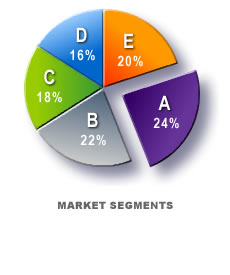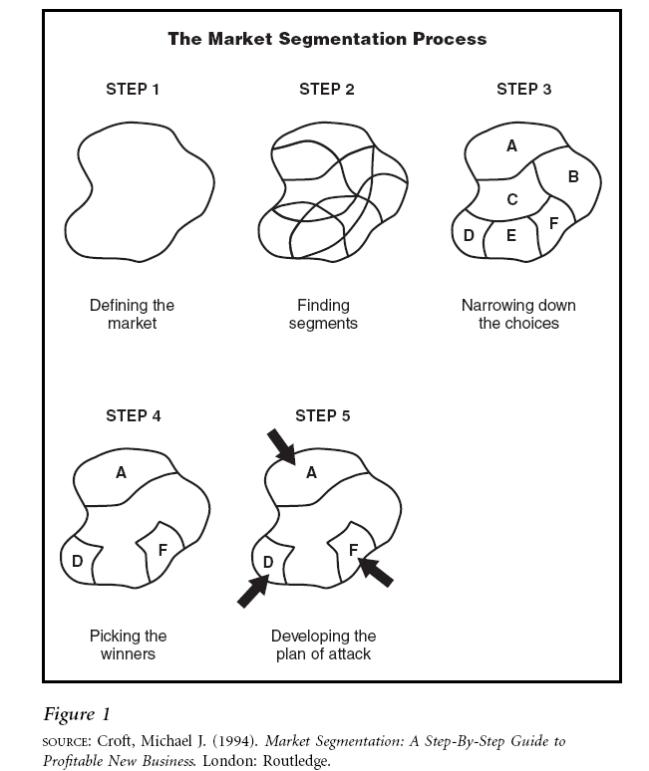
- •Introduction to marketing Посібник з розвитку навичок інтегрованого навчання студентів спеціальності «Маркетинг»
- •«Англійська мова»
- •Передмова
- •Introduction to marketing Words to know
- •I. Read the text and decide why the author chose the title Thinking like a marketer. Can you suggest a better title? Thinking like a marketer
- •II. Discuss the following questions:
- •III. Match terms in a column a with their definitions in a column b.
- •V. Here is a definition of marketing. Fill the empty spaces in the text by the following verbs.
- •VI. Read the text and give the definition of the term «marketing».Decide on suitable title for it. Using the chart below describe how the marketing process is developed.
- •XI. Translate the text in written form.
- •XII. Choose the best word or phrase from the columns a, b or c to fill the gaps.
- •XIII. Choose the best word from the brackets to fill the gaps.
- •XIV. Translate with a dictionary terms in the left column. Match up the words or expressions on the left with the definitions on the right.
- •XV. Replace the Infinitives in brackets by the Present Simple Tense in the Active Voice.
- •XVI. Answer the following questions:
- •Unit II The marketing research process
- •Words to know
- •I.Read the text and decide why the author chose the title The marketing research process. Can you suggest a better title?
- •The marketing research process
- •II. Answer the questions in your own words.
- •III. Look back at the text. Find nouns that follow these verbs:
- •IV. Match each word in the column a with a synonym in the column b.
- •VI. Now try to decide with a partner which methods are the best for researching:
- •VIII. Listen to the dialogue again and find words to fit the following definitions.
- •IX. Now complete the sentences below using the correct form of the words you have found.
- •X. Read the text and think of a title. Translate the text in written form.
- •XII. The marketing research firm has prepared the following script for the telephone survey. Work in pairs to ask and answer the questions.
- •XIII. Match the sentence halves (a to h) with the basic marketing steps (1to 8)
- •XIV. Look at these other methods for assessing available information and collecting new information about your customers. Sort them in the correct category. Can you add any more to the table?
- •XV. Choose the best word in brackets.
- •XVI. Read these comments about market research and say which options you agree with.
- •Unit III Planning the marketing strategy
- •Words to know
- •I. Read the text and decide why the author chose the title Marketing strategy. Can you suggest a better title.
- •Marketing strategy
- •II. Discuss the following questions:
- •III. Rewrite these sentences taken from the text Marketing strategy with the words in the correct order. The first word is underlined. There are sometimes two possibilities.
- •V. Read and translate the marketing strategy tips. Which of them do you agree with? Explain your choice.
- •VI. David is a marketing manager. He is organizing a meeting to discuss the prices for the cable Internet package. Put the following sentences in the correct order to complete the email.
- •Useful phrases
- •VII. Which word is the odd one out in each of these groups? Explain your choice.
- •VIII. Read the article and decide on the suitable title for it. Discuss the questions below.
- •X. Complete the sentences with these words.
- •XI. Martin is giving a presentation to management about the positioning strategy he has developed with his team. Listen and answer the questions below.
- •XII. Finish these notes about marketing strategy with the correct verb form of the given word.
- •XIII. Match terms in the column a with their definitions in the column b.
- •XIV. Look at the price list. Are the statements below true or false?
- •XV. Complete the sentences with the appropriate form of words from the exercise X.
- •Unit IV Branding
- •Wordlist
- •I. Read the text and decide why the author chose the title Brands and branding. Can you suggest a better title. Brands and Branding
- •II. Discuss the following questions:
- •III. Match the adjectives with the nouns they are most likely to be associated with:
- •IV. Look at the adjectives below and write down a company or product you associate with each one. Then compare your results with your partner. Did you write down any of the same companies/products?
- •VI. Define if these statements are true (t) or false (f).
- •VII. The text contains a number of common verb-noun partnerships. Match up these verbs and nouns to make common collocations.
- •VIII. Read the article about branding. Discuss with a partner the main steps in brand creating? How to create the best brand? Brand love by Peter Vane
- •IX. Representatives of three companies–a bank, a budget airline, and a car company- are giving presentations on their companies. Listen and make a note of each company’s brand values.
- •X. Listen again and complete these sentences from the presentations with words from the box.
- •Useful phrases
- •XIV. Translate the text in written form. Explain the difference between upmarket and downmarket. Upmarket and downmarket
- •XV. Correct the mistakes in italics, using expressions from the exercise XIV.
- •Unit V Market segmentation
- •I. Read the text and give the title. Sum up what the text says about the market-segmentation process.
- •II. Define if the statements are true or false.
- •III. Discuss the following questions.
- •IV. Match the words in a with those in b to make phrases from the text.
- •V. Circle the correct verb in these sentences.
- •VI. Read the text and find out:
- •Adopting marketing approach
- •VII. Choose the best word from the brackets to fill the gaps.
- •VIII. Look at the following marketing and advertising activities. Can you add any?
- •IX. Look at the following extracts from job advertisements. Match the titles to the job descriptions.
- •XI. Here are some more jobs and companies involved in marketing and advertising. Match them to the descriptions.
- •XII. Anna works in amedium-sized sporting company and is telling a new business partner who`s who in the department. Listen to the dialogue and complete the organigram.
- •XIII. Listen again and complete the sentences from the dialogue.
- •XIV. Think about job responsibilities you would like to have. Here are some phrases to get you started.
- •Useful phrases
- •XV. For each definition choose the correct word or phrase.
- •XVI. Find the answers to each clue. Some letters have been given to help you.
- •Unit VI Marketing сommunication
- •Read the text and write down two interesting things you remember. Compare with other students. Marketing communication theories
- •Are these sentences true or false, or does the text not say?
- •What do these words in italics in the text refer to?
- •Complete these sentences with a preposition (e.G. To, of). Then check your answers in the text by looking for the underlined words.
- •Complete these sentences with words in the box.
- •VII. Match the parts of the sentences given from the text.
- •VIII. Can you add any distribution channels below. Which channels are more efficient?
- •X. Now complete the crossword with words from the dialogue.
- •XI. Stefanie mentions a trade discount in her phone call. What other discounts are there? Match the discounts to their definitions.
- •XII. Discuss the following questions.
- •XIII. Read the text and give the title. Sum up what the text says about franchising. Translate the text in written form.
Unit V Market segmentation
Wordlist
call for |
вимогати |
dispose |
розташовувати, ліквідувати |
enable |
сприяти, надавати можливість |
entail |
влекти за собою |
good |
товар |
industrial market |
ринок виробників |
location |
розташування |
marketing communications |
рекламна діяльність |
mass-marketing |
масовий збут |
marketing mix |
маркетинговий комплекс |
market segmentation |
сегментація ринку |
market share |
питома вага на ринку даного товару |
perceive |
сприймати, розрізняти |
preference |
перевага |
product benefits |
товарна вигода |
profitably |
рентабельно, вигідно |
prospective consumer |
потенційний споживач |
psychographic characteristics |
психографічні характеристики |
Public Utilities |
комунальні компанії |
responsive |
чуйний |
pursue |
переслідувати, добиватися |
target marketing |
цільовий ринок |

I. Read the text and give the title. Sum up what the text says about the market-segmentation process.
Market segmentation is one of two general approaches to marketing; the other is mass-marketing. In the market-segmentation approach, the total market is viewed as being made up of several smaller segments, each different from the other. This approach enables businesses to identify one or more appealing segments to which they can profitably target their products and marketing efforts.
The market-segmentation process involves multiple steps (Figure 1).

The first is to define the market in terms of the product’s end users and their needs. The second is to divide the market into groups on the basis of their characteristics and buying behaviors.
The most common elements used to separate consumer markets are demographic factors, psychographic characteristics, geographic location, and perceived product benefits.
Demographic segmentation involves dividing the market on the basis of statistical differences in personal characteristics, such as age, gender, race, income, life stage, occupation, and education level.
Psychographic segmentation is based on traits, attitudes, interests, or lifestyles of potential customer groups. Companies marketing new products, for instance, seek to identify customer groups that are positively disposed to new ideas.
Geographic segmentation entails dividing the market on the basis of where people live. Divisions may be in terms of neighborhoods, cities, counties, states, regions, or even countries.
Product-benefit segmentation is based on the perceived value or advantage consumers receive from a good or service over alternatives. Thus, markets can be partitioned in terms of the quality, performance, image, service, special features, or other benefits prospective consumers seek. Many companies even market similar products of different grades or different accompanying services to different groups on the basis of product-benefit preference.
Once potential market segments are identified, the third step in the process is to reduce the pool to those that are (1) large enough to be worth pursuing, (2) potentially profitable, (3) reachable, and (4) likely to be responsive. The fourth step is to zero in on one or more segments that are the best targets for the company’s product( s) or capacity to expand. After the selection is made, the business can then design a separate marketing mix for each market segment to be targeted.
